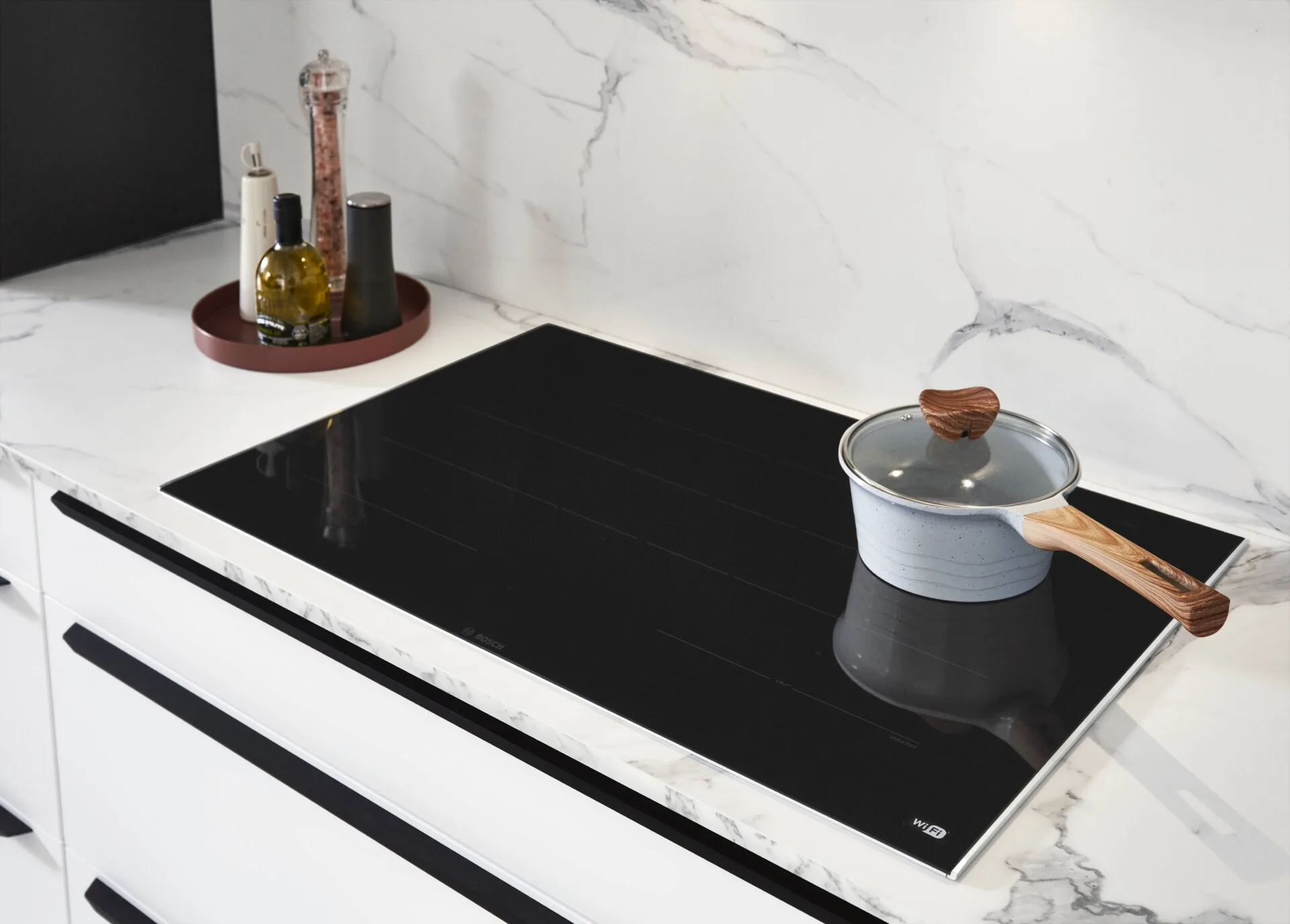With the advance of technology in appliances, we have won a lot in Energy efficiency, leaving behind gas stoves and gradually replacing them with hob and induction plates.
Glass-ceramic hobs and induction hobs are two types of systems that present technological development in the sector. Both types of hobs coexist on the market and both are successful and functional for people when working in the kitchen.
In today's article, we expose the differences between kitchens with induction hobs and kitchens with ceramic hobs.
In Cocinas Plus We are custom kitchens specialists. Contact us for more information.
What is an induction cooker?
The Induction plate It is a kitchen, it is a type of electric cooking surface that uses Electromagnetic fields To generate heat directly in the kitchen containers instead of heating the surface of the plate.

Operation of a kitchen with an induction hob
- Electromagnetic field generation: Under the surface of the plate, generally manufactured of tempered or ceramic glass, copper coils are found. When the plate turns on, an alternating electric current passes through the coils, generating a variable magnetic field.
- Induction in the container: When placing a ferromagnetic container (made of iron or stainless steel suitable) on the plate, the magnetic field induces electric currents called Foucault currents at the base of the container. These currents circulate through the metal of the container, which causes electrical resistance that generates heat.
- Direct warming of the container: The heat is generated directly at the base of the container, without heating the surface of the plate. This allows energy to be concentrated where it is necessary, improving the efficiency and reducing heat losses. The surface of the plate is barely heated, except for the residual heat transmitted by the container after heating.
- Temperature and power control: Technology allows precise and fast temperature control, since by adjusting the electric current in the coils, the intensity of the magnetic field is modified and, therefore, the amount of heat generated.
Advantages of induction hobs
- Energy efficiency: They heat quickly and lose less energy by not heating the surrounding air.
- Security: The surface does not heat up too much, reducing the risk of burns.
- Precise temperature control: They allow rapid and exact temperature adjustments.
- Easy to clean: The flat and cold surface prevents food from adhere and facilitates cleaning.
- Speed: They can boil water or cook food faster than other systems such as gas or hob.
What is a kitchen with a ceramic hob?
A kitchen with Watercard plaque It is a type of electric cooking surface that uses Electrical resistance located under a ceramic glass surface to generate heat. This heat is transmitted from the plate to the containers and, therefore, to food.

How a ceramic hob works
- Electrical resistances: Under the ceramic glass surface, electrical resistance or radiant elements are found. When the plate is turned on, resistances generate heat to the passage of electric current.
- Heat transmission: The heat generated by the resistances is transmitted up, heating the ceramic glass surface. From the hot surface, the heat is transferred to the containers and, subsequently, to the food.
- Ceramic glass surface: Ceramic glass is a heat resistant material and sudden changes in temperature. In addition, its surface is flat and easy to clean.
- Temperature control: The power and temperature are regulated by electronic controls, which allows cooking with different heat levels. However, the response to temperature changes is slower compared to induction.
Advantages of glass ceramic
- Easy to clean: Its flat surface allows to clean spills easily.
- It can be used with any material: It does not require special containers.
- Modern aesthetics: It has an elegant and minimalist design.
What are the differences between a stove and induction and ceramic hobs?
Both plates, induction and HobbinThey have in common a ceramic glass surface that provides an elegant appearance and facilitates cleaning. However, its operation, efficiency and characteristics present clear differences:
- Operation: Induction plates use electromagnetic fields generated by copper coils located below the surface. These electromagnetic fields induce electric currents at the base of the container, generating heat directly in the container, not on the plate. However, hob plates work with electrical resistances or radiant elements under the ceramic glass surface. These resistance heat the surface of the plate, which in turn transmits heat to the container placed on top.
- Speed and energy efficiency: The induction plate is faster when heating the containers, since the heat is generated directly at the base of the same and has greater energy efficiency (approximately 85-90%) because there are hardly any heat losses to the environment. The hobbin plate is slower because it needs to first heat the ceramic glass surface, to subsequently transfer the heat to the container. Its energy efficiency is lower (around 60-70%) due to heat losses to the environment and the time it takes to heat and cool.
- Temperature control: Induction plates offer much more precise temperature control, since they allow the power to be virtually instantaneous. However, in the Watercomm with the temperature control is slower, both when climbing and down, due to thermal inertia.

